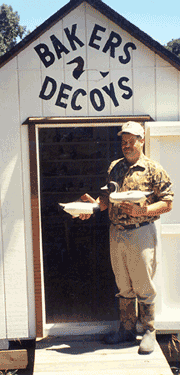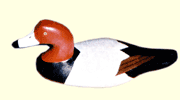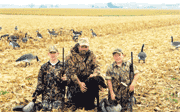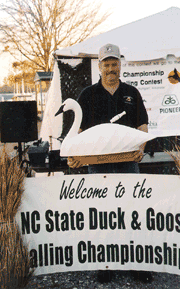The Hunt for a Living
On the job with Capt. Dan Baker III
by B.C. Phillips
Across the kitchen table, Captain Daniel Baker III tells me about his childhood. But the instant he hears the geese flying low over the farm he rises, mid sentence, and goes to the rack near the door where his bird calls hang. Fifteen-year-old Daniel Baker IV follows close behind.
It is an evening ritual for father and son, in the cold season of the year, when the geese take wing to their nightly sanctuaries on the river.
“We like to play with them a little,” says Baker, a tall, mustachioed outdoorsman in jeans and camouflage shirt. “See if we can make them turn around and land in the yard.”
No harm is intended in these playful exchanges between man and bird. But the geese, if they land, stray unknowingly onto the home territory of a licensed Master Hunting Guide.
By day, Baker puts in his 40 hours as an electrician for the Calvert County government. He learned the trade from his father and it pays the bills. Nights, weekends and holidays remain devoted to what is indisputably his true calling: hunting and its associated arts.
Over the years, slowly but surely, Baker has worked his lifelong passion into a thriving, multi-faceted side business known as Baker’s Decoy and Guide Service. Now he thinks he just might become a full-time professional outdoorsman.
Hunting and Its Associated Arts
Baker’s 36-acre St. Leonard farm, sandwiched between the Patuxent River and St. Leonard’s Creek, has become a nerve center for Southern Maryland hunters. To the left of the driveway is Baker’s Meathouse, started in 1988, where, in the height of the season, over 80 deer hang in cold storage waiting to be butchered by the former grocery meat cutter. Every year some of this meat gets donated to the national Farmers and Hunters Feeding the Hungry program.
A little closer to the house is Baker’s Decoy Shop, which came to life in the early 1990s. Here, on cold winter nights, wooden models of wildfowl — mostly ducks — are lovingly carved and restored. Baker carves alone and with friends by the old woodstove, below walls lined with works in progress.
“A lot of people come in here just to sit and talk with me while I’m carving. We tell stories, practice goose calls, carry on.”
He uses an old gunstock machine from the 1920s to get a basic shape out of a block of wood. A draw knife in hand works the details of head and feathers. Baker pulls the shapes from memory, profiting from hours upon hours of watching flocks in the field and on the water. A belt sander smooths the blade-worn surfaces.
The models that emerge from this work do not have a cookie-cutter sameness. “To give life to the flock,” he says, he gives the birds different, characteristic waterfowl poses. There are, for instance, preeners, with beaks buried in would-be feathers; swimmers, with heads stretched forward in exertion; and sleepers, with necks turned around at rest on feathered backs.
The decoy doesn’t come to life, however, until it takes the paint. This is where, in patterns of line and color, Baker’s touch is most his own, whether the piece originated in his shop or is an antique taking on new regalia.
Every painter has his own trademark, and like a connoisseur of fine paintings, Baker can identify the work of a known decoy maker simply by studying his brushstrokes. He can tell you when the decoy was made and by whom, and whether that artist was an apprentice or a great master. Was it R. Madison Mitchell, who made over 100,000 decoys out of Havre de Grace up until his death in 1993? Or was it Jimmy Pierce, his assistant?
Baker’s collection of antique decoys numbers in the hundreds, which is not surprising when you consider he began collecting at age 10. He’s been carving his own for about as long, although his keen authority reckons the early models were nothing to impress: “They were right rough,” he says.
Speaking the Language of Swans
Baker’s love of decoys stems from more than their use in hunting. He has the appreciation for natural beauty of an accomplished outdoorsman, of one who has made a life in reverent observation of Earth’s creatures.
He recalls working at the North Beach wastewater plant, spending his off-hours behind Cheney’s Restaurant, drinking coffee and videotaping water birds on the Bay. He can tell you all about the way mallards feed along the shore, how canvasbacks swim in lines, not groups, and how blackheads prefer to keep to themselves.
When Baker speaks to the migratory geese in their own tongue (he also knows duck, turkey, swan, even owl and crow), it is likewise with an understanding born of life-long study.
As a boy at his granddad’s house in Mayo, he began to imitate the calls of ducks, speaking to them as he threw them corn.
Baker’s granddad, who also had a house in Solomons, introduced his grandson to the waterman’s life. But Baker’s father wanted to try his hand at farming, and in 1976 he bought the St. Leonard farm, where Baker and his family live today. The 10-year-old Baker immediately got into trapping muskrats and raccoons and hunting squirrels. At age 11, he shot his first deer.
Still, he missed the water.
“My dad grew up on the water and always wanted to be on the farm. I grew up on the farm and always wanted to be on the water,” he says.
At 15, he bought his own john boat, at first working eel pots and gill nets. Then he demonstrated his duck calling for his friend Andy Buck.
“After hearing my duck calling, Andy said, ‘I need to get you in the duck blind.’”
Baker has been hunting on the water ever since.
In 2000, after the butcher and decoy shops were well established, Baker began running hunting parties for friends and acquaintances. He has coveted access to hunting grounds, knowing farmers on both sides of the Bay from his days helping his father. He was spending so much time and money as a guide that his wife suggested he start charging. With a Captain’s Certification from the Coast Guard and a Master Hunting Guide license from the Maryland Department of Natural Resources, Baker’s Guide Service was born.
In the meantime, Baker became a champion in the world of game calling. His climb started with a sixth-place finish in the World Goose Calling contest in Easton, followed shortly by two first-place wins in the 2003 and 2004 Turkey Calling Contests of the National Outdoor Show. In February, 2005, Baker won the World Swan Calling Contest in Washington, North Carolina, followed by a second-place finish this year.
These triumphs have made him a kind of celebrity endorser, promoting the products of Mountain Hollow Game Calls of New York and Allen Stanley Game Calls of Delaware as a member of their pro-staffs.
The talent seems to run in the family. Danny IV has won national contests in duck, turkey and goose calling, all with just his mouth. That’s right: No calling instrument necessary. His dad couldn’t be more proud.
A Master of Observation
I stand with Capt. Baker beside the porch on the highest point of his land. Jefferson Patterson Park and the Patuxent River are within view. But we are watching a long V of Canada geese move east towards the gray water.
The nuanced and varied sounds of the geese often leave human interpreters guessing. Baker explains that the familiar barking honk made by feeding gaggles to overhead flocks is not meant to invite the flying birds to land but to warn them away. Fortunately for hunters, flying birds know the warning calls mean food is near and will attempt to land and grab their share.
The calls Baker demonstrates for me are loud, fierce and startlingly real from three feet away. So real that I’m swept back to my childhood in northern Calvert County, when the honks and screeches of the geese on the pond were a ubiquitous part of the winter soundscape, both comforting and eerie.
The geese return his hails, but they do not turn.
“I wouldn’t trade this for anything,” Baker says.
Back in the house, he asks me about writing. He wants to know all about it: how I got started, my writing process, what I think of the work. He longs to write a book about waterfowl hunting on the Western Shore of the Bay, a book of family histories and regional practices. He wants to tell the stories of the great decoy carvers. He watches and listens to me as if he can learn my ways by studying me.
This is where Baker excels, in careful observation. He has studied the chances of succeeding as a hunting entrepreneur, biding his time, putting in the work, building up his business, bit by bit.
“Sometimes I come home and fall on the floor beat, but I love it.”
Full-time hunting? He’ll give it a go.
Hunting seasons for deer, geese, ducks and other wild game run throughout the fall and winter. For specific dates and hunting regulations, visit the Maryland Department of Natural Resources at www.dnr.state.md.us/huntersguide. Find Baker’s Decoy and Guide Service on the web at bakerdecoys.com.
Calvert County native B. C. Phillips is seeking his fortune in New York City. His last story for Bay Weekly was Joan Lehmann: ER Doctor in The Fast Track (Vol. xiv, No. 22: June 1, 2006).
